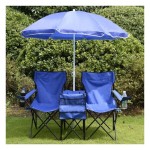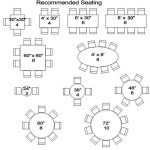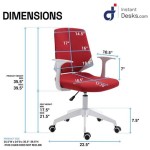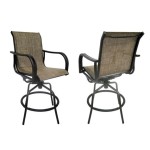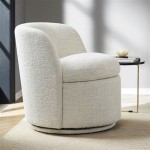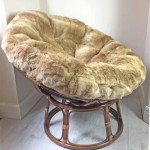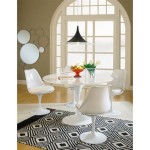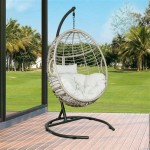Balcony Height Table And Chairs: A Comprehensive Guide
Optimizing the functionality and aesthetic appeal of a balcony space often hinges on the selection of appropriate furniture. Balcony height tables and chairs represent a specific category of furniture designed to complement the elevated nature of these outdoor areas. Understanding the nuances of balcony furniture, including height considerations, material choices, and design styles, is crucial for creating a comfortable and inviting outdoor living space.
This article explores the key aspects of balcony height tables and chairs, offering guidance on selecting the most suitable options for various balcony types and individual preferences. The goal is to provide a comprehensive overview, enabling informed decision-making when furnishing a balcony space.
Understanding Balcony Heights and Furniture Proportions
The term "balcony height" as it relates to tables and chairs, doesn't refer to a standardized measurement like "counter height" or "bar height" found indoors. Instead, it describes furniture that is proportionally sized to fit comfortably within the often-limited space of a balcony and to facilitate unobstructed views. The height of balcony furniture is less about a specific numerical measurement and more about achieving visual harmony and functional ergonomics within the balcony environment.
Standard dining tables generally measure between 28 and 30 inches in height. A balcony dining table, however, might be slightly lower to maintain sightlines and prevent the furniture from dominating the space. Similarly, standard chairs are typically around 18 inches from seat to floor. Balcony chairs may be designed with a slightly lower seat height or a more streamlined profile to complement the table and maximize space.
Visualizing the proportions is crucial before making a purchase. Measuring the available balcony space, including height restrictions (such as overhangs or railings) and width/depth dimensions, is a necessary first step. This allows for an accurate assessment of the furniture's potential impact on the overall balcony aesthetics and usability. Considering the views from inside the building through balcony doors or windows is equally important. Taller furniture might block these views, diminishing the connection between the interior and exterior spaces.
Balcony furniture height also influences comfort. If a table is too low relative to the chair seats, it can lead to uncomfortable posture during meals or other activities. Conversely, a table that is too high can make it difficult to relax and enjoy the space. Selecting furniture with complementary heights ensures a comfortable and ergonomically sound experience.
Material Considerations for Balcony Furniture
The choice of materials for balcony height tables and chairs is paramount due to their exposure to the elements. Weather resistance, durability, and maintenance requirements are essential factors to consider. Common materials used in balcony furniture construction include:
*Wood:
Teak, cedar, and acacia are popular wood choices due to their natural resistance to moisture, decay, and insects. Teak is particularly prized for its longevity and ability to withstand harsh weather conditions. Wood furniture offers a classic and warm aesthetic, but it requires regular maintenance, such as oiling or sealing, to preserve its appearance and structural integrity. The frequency of maintenance depends on the specific type of wood and the climate. *Metal:
Aluminum and wrought iron are common metal options. Aluminum is lightweight, rust-resistant, and relatively low-maintenance. Powder-coated aluminum provides added protection against scratches and corrosion. Wrought iron is heavier and more durable, offering a more traditional and ornate aesthetic. However, it is susceptible to rust and requires regular painting or sealing to prevent corrosion. Stainless steel is another durable option that offers excellent corrosion resistance, but it can be more expensive than aluminum. *Resin Wicker:
Resin wicker is a synthetic material made from polyethylene or polyvinyl chloride. It is designed to mimic the look of natural wicker, but it is much more durable and weather-resistant. Resin wicker is easy to clean and requires minimal maintenance. It is available in a wide range of colors and styles, making it a versatile option for balcony furniture. However, low-quality resin wicker can become brittle and crack over time, so it is important to choose a high-quality product. *Plastic:
Plastic furniture, particularly that made from recycled materials, is a budget-friendly and environmentally conscious option. Plastic is lightweight, easy to clean, and resistant to moisture and insects. However, it can be less durable than other materials and may fade or become brittle in direct sunlight. Look for UV-resistant plastic to prolong its lifespan.The choice of material should be guided by the local climate, the desired aesthetic, and the level of maintenance the user is willing to perform. In coastal areas with high humidity and salt air, materials like aluminum, stainless steel, and resin wicker are particularly well-suited. In drier climates, wood furniture may be a viable option as long as it is properly maintained.
Cushions and upholstery also require careful consideration. Outdoor fabrics should be water-resistant, fade-resistant, and mildew-resistant. Popular choices include Sunbrella, Olefin, and other solution-dyed acrylic fabrics. These fabrics are designed to withstand prolonged exposure to the sun and rain without losing their color or integrity. Proper cleaning and storage of cushions and upholstery during inclement weather can further extend their lifespan.
Design Considerations for Balcony Furniture
The design of balcony height tables and chairs should complement the overall aesthetic of the balcony and the adjacent interior spaces. Style, functionality, and space optimization are all important design considerations.
*Style:
Balcony furniture is available in a wide range of styles, from traditional to modern to bohemian. The choice of style should reflect the homeowner's personal taste and the architectural style of the building. Traditional styles often feature ornate details and classic materials like wrought iron and wood. Modern styles tend to be more minimalist and streamlined, with clean lines and materials like aluminum and resin wicker. Bohemian styles often incorporate natural materials, vibrant colors, and eclectic patterns. *Folding and Stacking Furniture:
Space is often at a premium on balconies, making folding and stacking furniture a practical choice. Folding tables and chairs can be easily stored away when not in use, freeing up valuable space. Stacking chairs allow for efficient storage and can be easily deployed when needed. These options are particularly well-suited for smaller balconies or those that are used for multiple purposes. *Bistro Sets:
Bistro sets, typically consisting of a small round table and two chairs, are a classic choice for balconies. They provide a cozy and intimate setting for enjoying meals or drinks outdoors. Bistro sets are available in a variety of materials and styles, making it easy to find one that complements the balcony's aesthetic. *Built-in Seating:
Built-in seating, such as benches or banquettes, can be a space-saving and visually appealing option for balconies. Built-in seating can be customized to fit the specific dimensions of the balcony and can provide ample seating for guests. It can also incorporate storage space underneath the seats, further maximizing the functionality of the balcony. *Color and Texture:
The color and texture of balcony furniture can significantly impact the overall ambiance of the space. Neutral colors like white, gray, and beige create a calming and sophisticated atmosphere. Brighter colors like blue, green, and yellow can add energy and vibrancy. Texture can be added through materials like woven resin wicker, textured cushions, and patterned rugs. Consider the existing color palette of the balcony and the adjacent interior spaces when selecting furniture colors and textures to create a cohesive and harmonious design.Beyond these considerations, ergonomic design is crucial. Chairs should provide adequate back support and be comfortable for extended periods of sitting. Tables should be at a comfortable height for dining or working. Consider adding cushions and pillows to enhance comfort and personalize the space. Selecting furniture that is both aesthetically pleasing and ergonomically sound ensures that the balcony is a comfortable and enjoyable place to spend time.

Pawleys Island Hammocks Outdoor Furniture Bar Height

Outdoor Furniture Florence Series Wa4039 Bar Counter Table Picket Rail Custom Sofas

Bazza 6 Person 62 Hexagonal Balcony Height Outdoor Dining Set By Telescope Casual Best Fire Hearth Patio

Outdoor High Top Table And Chair Patio Furniture Set With Glass Coffee Removable Cushions Bar

Abbott Concrete Acacia Outdoor Bar Height Table 34 Pottery Barn

Phi Villa 5 Piece Metal Outdoor Patio Bar Height Dining Set With Rectangle Table And Rattan Wicker Stool Thd5 454093bc The Home

Durawood Poly Sunrise Bar Height Combo Srhd Pawleys Island Hammocks

Fairen Trail 5pc Outdoor Bar Table Set Louisville Overstock Warehouse

Dextrus 5 Pcs Outdoor Bar Height Table And Chair Set With Swivel Chairs Faux Wood Top Red

Bar Height Patio Dining Sets The Home
